

设计单位 优意建筑设计(上海)有限公司
项目地点 上海市
建成时间 2022年
建筑面积 300平方米
本文文字由设计单位提供。
四海为家的人
A Home for Global Nomads
二十一世纪的前二十年是一个全球化和崇尚流动性的时代,四海为家是时代对个人自由的最高赞誉。对于一位世界旅行者来说,住在什么地方都需要随遇而安。因此,当我们要为旅途中的短暂停留设计一个“栖息地”时,需要强调基地的特征,并且对“栖息地”的概念做一个定义。
The first two decades of the 21st century have been marked by globalization and a celebration of mobility.Being at home anywhere in the world is seen as the ultimate expression of personal freedom in this era.For a world traveler, adaptability is key when choosing a place to stay.Thus, when designing a temporary "haven" for a brief stopover, it’s essential to highlight the characteristics of the location and redefine the concept of "haven."
俯瞰农田的“阁楼”
A "Loft" Overlooking the Fields
项目的业主是一对父女,他们需要在上海设置一个“栖息地”,以便每年一个月不定期的短暂停留,并且偶尔还需招待朋友。
The project’s clients, a father and daughter, needed a "haven" in Shanghai for their irregular, month-long stays throughout the year, with the occasional need to entertain friends.
基地位于上海郊区,一栋四层建筑的顶层。建筑的西面是一片永久农业用地,这是基地最有吸引力的特征。得益于耕地红线政策,这块土地会保留农业种植功能。“农田比公园更美,因为它不考虑美学。”田野的空旷正是现代城市中稀缺的特征,业主希望在这个房子里,可以一直欣赏到农田四季变化的色彩。基地的其他方向朝向园区内部,并无明确的特征。
The site is located in the suburbs of Shanghai, on the top floor of a four-story building.To the west of the building lies a stretch of permanent agricultural land, which is the most attractive feature of the site. Thanks to the protection of the farmland preservation policy, this land will retain its agricultural function. The openness of the fields, scarce in modern urban environments, provides a unique contrast to city living.The owners wish to enjoy the changing colors of the farmland throughout the seasons from their home."Farmland is more beautiful than a park because it doesn’t concern itself with aesthetics."The other sides of the site face inward toward an industrial park and lack distinctive features.


临时的栖息地
A Temporary Haven
业主对“栖息地”的定义如下:
- 一个暂时停留的落脚点,每年不定期使用一个月;
- 满足日常生活的一切需求,例如卧室、厨房和储藏等;
- 去除生活的痕迹;
- 可容纳众多收藏品的空间;
- 既能满足独处,又能满足多至30人的聚会;
- 绝对隐私(即使在女儿举办30人聚会时,父亲需要保持独处的可能性);
最后以及最重要的一点:
- surprise me:空间的戏剧性和不可预知
The client defines the concept of "haven" as follows:
- A temporary stopover point, used irregularly for one month each year;
- Equipped to meet all daily living needs, such as a bedroom, kitchen, and storage;
- Free from traces of daily life;
- A space that accommodates numerous collections;
- Suitable for both solitude and gatherings of up to 30 people;
- Absolute privacy (even when the daughter hosts a 30-person gathering, the father must still have the option to remain in solitude).
Lastly, and most importantly:
Surprise me: The space should evoke drama and unpredictability.

基本矛盾
Fundamental Contradictions
一个无论在独处时或者举行30人聚会时都可以保持私密性的空间;
一个实用却没有生活痕迹的住所。
A space that maintains privacy whether used for solitude or for a gathering of 30 people.
A functional residence that leaves no traces of daily life.
这些要求展示了项目的基本矛盾:一是设计需满足日常居住的需求,但去除日常生活痕迹。维持空间空旷是反人性的,现代人收集一切物品,藏品与日俱增,空间日益紧张。最开始的轻盈状态能否抵抗必然增长的收集(储藏)需求?二是30人聚会和绝对隐私如何共存,并且彼此不会意识到对方的存在?
These requirements highlight the project’s fundamental contradictions:The need to fulfill daily living requirements while erasing any signs of daily life. Keeping the space free of clutter defies human nature, as modern individuals tend to accumulate objects. As collections grow and space becomes more limited, can the initial light and airy state of the space resist the inevitable increase in storage demands?How can a 30-person gathering coexist with absolute privacy, ensuring that neither party is aware of the other's presence?
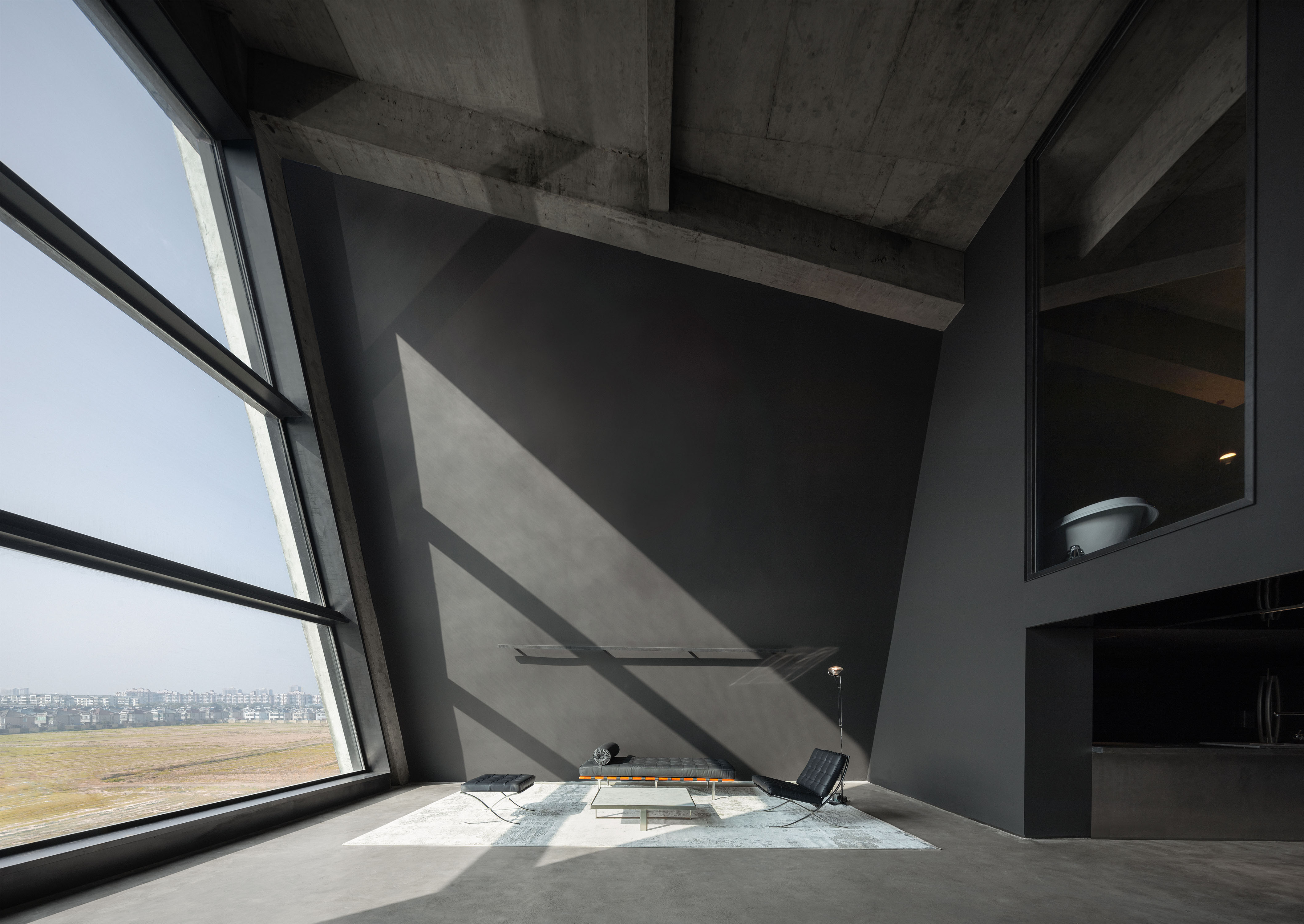

实与空
Substance and Emptiness
“埏埴以为器,当其无,有器之用。凿户牖以为室,当其无,有室之用。”
"Shape clay into a vessel, it is the void within that gives the vessel its utility. Carve doors and windows to make a room, it is the empty space within that makes the room useful."
我们构造这样一种模式——空间由两个部分组成:一个始终保持空旷的部分+一个允许被逐渐填充的部分;一个极为公共的部分+一个极为私密的部分,允许开放的公共部分没有固定的功能,私密部分容纳所有功能。
We constructed a model based on this principle——The space is divided into two parts:One part remains perpetually empty + another part allows for gradual filling,One part is highly public + another part is extremely private;The open, public part has no fixed function;The private part contains all essential functions.

在这个模式里,空旷的空间被服务空间所包围,服务空间容纳生活所需要的所有功能,包括不断增长的储藏。在最终状态,服务部分将会被藏品完全占满,形成类似于实体的固态空间,类似中世纪城堡的图底关系:拥有坚固的厚墙和难以发现的秘密通道。与此同时,公共部分则是从一大片实体中“挖出”的空腔。这一部分保持家徒四壁的状态,也许有少量必需的家具,但不需要承担建筑的任何功能。因此作为一个空地,它可以随时转化为任何功能空间,其核心特征是刻意保持的空旷状态。
In this model, the empty space is surrounded by service spaces, where all functional areas required for daily living, including ever-increasing storage, are housed. In its final state, the service areas will be completely filled with collections, forming a solid, dense space similar to the figure-ground relationship of a medieval castle, with thick, impenetrable walls and hidden passageways.Meanwhile, the public space is a void carved out of this mass. This part remains bare, perhaps containing only a minimal amount of essential furniture. Since it is not required to serve any specific function in the architecture, it remains an open area that can be transformed into any functional space as needed. Its key feature is the deliberate maintenance of an empty state.

“空”的空间:显性的空间序列
The "Empty" Space: An Explicit Spatial Sequence
这一透明序列专为客人设计,引导他们经过一系列精心策划的空间,从而增强在空间中游走的戏剧性体验。
This transparent sequence is designed specifically for the guests.Guests arriving at this public space will pass through a meticulously designed sequence, enhancing the dramatic experience of moving through the space.
从电梯抵达入口门厅,门厅是一个边长2.2米的黑色金属立方体盒子,其中一面是透明的玻璃,可以透过入户花园看到外部明亮的景色。门厅的金属门开向一个狭窄、高耸、黑色的走廊。走廊的宽度只能容一人通过,唯一的采光来自侧面狭长的横窗。横窗与人的视线等高,人们可以通过狭小的窗洞观赏室外被截取的片段,这些片段被窗洞周边的镜面不锈钢反复反射,将外部普通的景象转化为万花筒的图案。凸向室内的窗套表面也用镜面不锈钢覆盖,将外部的光线投射到走廊的黑色墙面上,随着阳光角度的不断变化,在黑色空间中形成灵动的光斑。
From the elevator, guests first reach the entrance hall, a black metallic cube with a 2.2-meter edge. One side of this cube is transparent glass, allowing them to view the bright outdoor scenery through the entrance garden.The metal door of the hall opens into a narrow, towering black corridor. The corridor is just wide enough for a single person to pass through, with lighting provided solely by a narrow horizontal window along one side, aligned at eye level. Through this narrow window, guests can glimpse fragmented views of the outdoors. These views are repeatedly reflected by mirrored stainless steel surrounding the window, transforming the ordinary exterior landscape into a kaleidoscopic pattern. The window casing, which protrudes inward, is also clad in mirrored stainless steel, reflecting light into the black walls of the corridor. As the sunlight shifts throughout the day, dynamic patches of light dance naturally within the dark space.

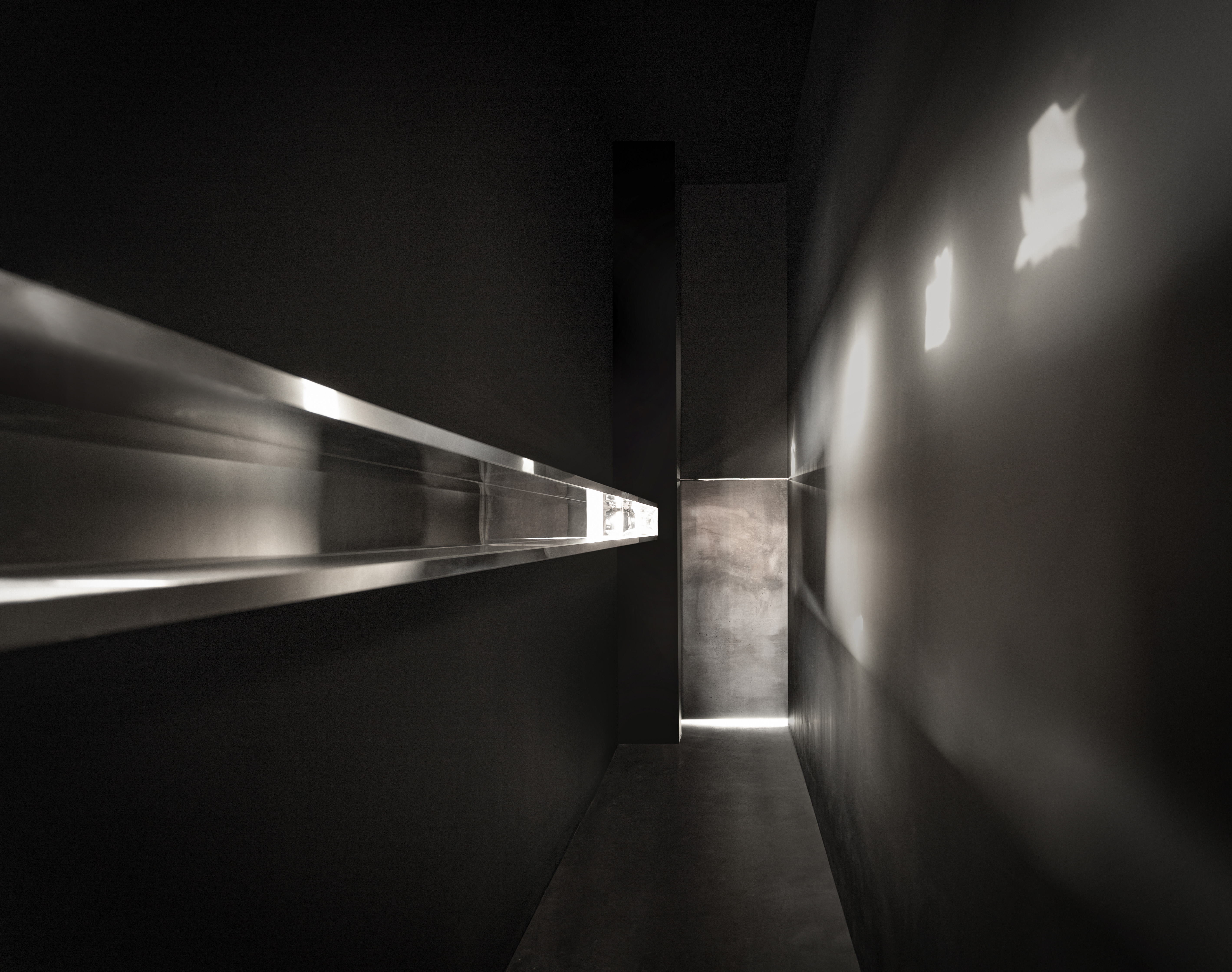
走廊尽头巨大厚实的金属门悄无声息地向内旋转打开,访客从最暗的空间直接进入巨大明亮的变形立方体空间。在这个主空间中,面向外部田野的墙面整体被完全打开,室内和室外之间隔着3块大片的横向玻璃,形成一扇7米宽、6.6米高的巨大梯形窗扇。
At the end of the corridor, a thick, heavy metal door silently swings inward, allowing guests to step from the darkest part of the journey directly into a bright, expansive, deformed cube-shaped space. In this main space, the wall facing the fields is completely open, with only three large horizontal glass panes separating the interior from the exterior. This forms a giant trapezoidal window, 7 meters wide and 6.6 meters high.
在这个空间中,一处墙壁是玻璃的,其余的墙壁和地面则是有着微妙差别的黑色。这样的设计让外部和内部之间的相遇得到了强调,黑暗的内部使大自然仿佛猛然跃入建筑内部。窗外的田野在每天、每个季节的轮替中,犹如一幅四季变化的画作,成为内部所有行为展开的背景。
Inside this space, one wall is entirely glass, while the remaining walls and floor are various subtle shades of black, emphasizing the meeting of the exterior and interior. The darkness inside makes it feel as if nature is suddenly leaping into the architecture. The fields outside, with their daily and seasonal changes, resemble a painting of the four seasons, forming the backdrop for all activities within.


“实”的空间:隐藏的空间序列
The "Solid" Space: A Hidden Spatial Sequence
为主人设计的隐藏空间序列隐藏在“实”的体量之中。“实”的部分中包含众多必要的功能空间,其中两处隐秘的楼梯和三处捷径能够使主人的路径成为网状,空间也因此增添了复杂性和使用的可能性。
A hidden spatial sequence, designed for the owner, is embedded within the "solid" mass of the building. The solid portion houses numerous functional and storage spaces, concealing two secret staircases and three shortcuts, creating a networked path for the owner. This adds a significant layer of complexity and versatility to the space.
楼上空间包含两个较小的阁楼卧室。两个卧室拥有各自的卫生间,因此在功能上既可以合并,也可以独立使用。为了确保最高的隐私,每个阁楼拥有专用的楼梯:其中一部楼梯位于一处储藏间的内侧,另一部位于隐蔽的后勤走廊尽端。这样,即使聚会的客人进入后勤的区域,没有主人指引也很难发现通往楼上的通道。
The upper level contains two smaller loft bedrooms, each with its own bathroom, allowing for either combined or independent use. To ensure ultimate privacy, each loft has its own dedicated staircase. One staircase is tucked away inside a storage room, while the other is located at the end of a concealed service corridor. This layout makes it difficult for guests to discover the stairways to the upper floor without guidance from the owner, even if they venture into the service areas during a gathering.


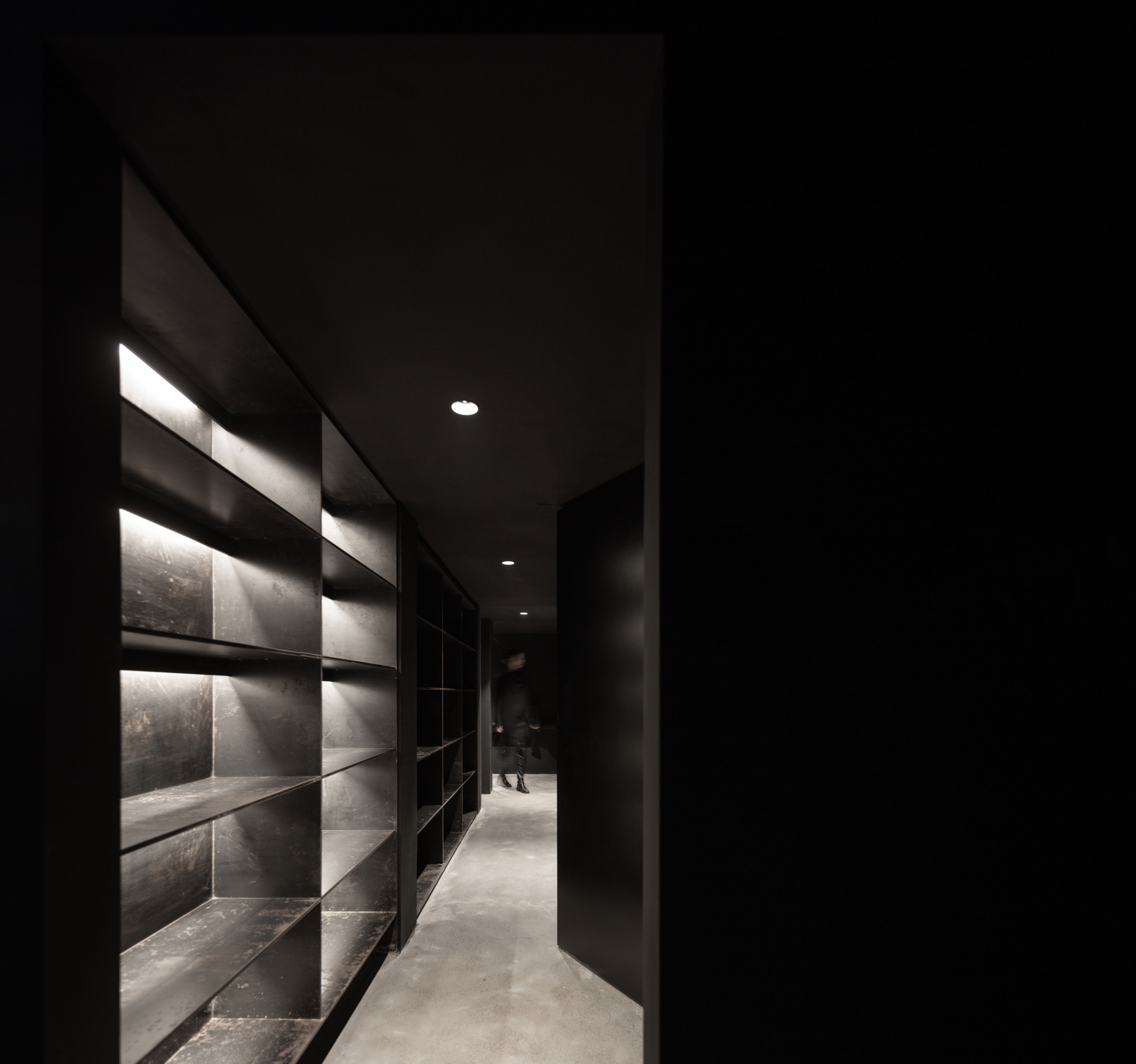

由于空间要素的尺度、位置的多样性,建筑的公共部分和私密部分形成了复杂的空间边界;由于对建筑复杂度认知的差异,主人可以轻易跨越边界,客人则难以发现隐秘的通道。这座建筑是主人的城堡,客人的迷宫。
The scale and diversity of spatial elements create a complex boundary between the public and private sections of the building.Due to differing levels of familiarity with the space’s complexity, the owner can easily cross these boundaries, while guests find it challenging to detect the hidden passageways.This building serves as a castle for the owner and a labyrinth for the guests.
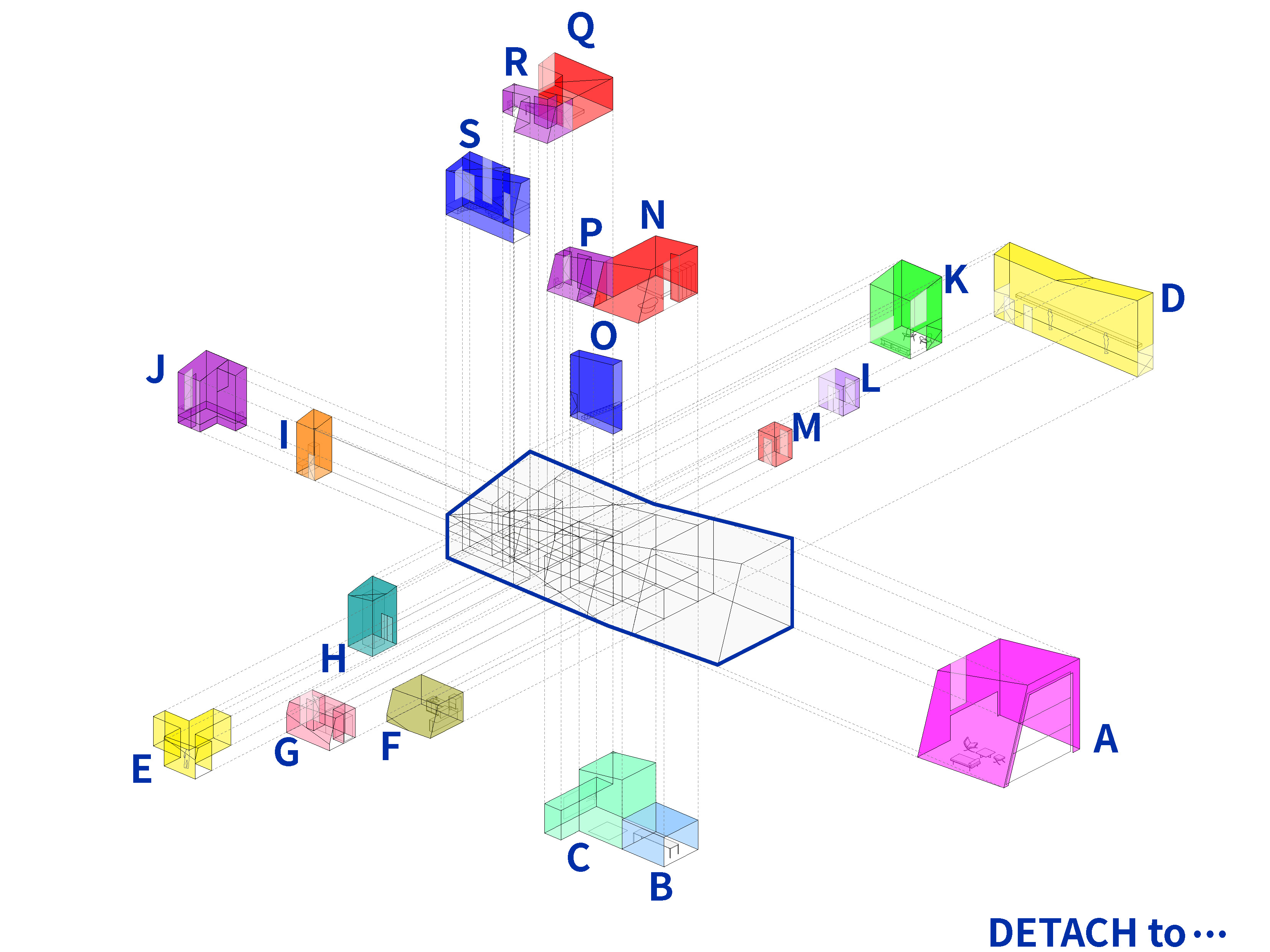

免维护的美学
Maintenance-Free Aesthetics
作为一个一年中短暂停留的“栖息地”,它应该易于维护,并处于随时可用的状态。一旦需要业主花费巨大的时间和精力去维持,拥有就会变成一种负担,然后再也无法以放松的心态去使用了。
As a "haven" for brief stays throughout the year, it should be easy to maintain and ready for use at any time. If significant time and effort are required for upkeep, ownership could become burdensome, making it difficult to enjoy the space with a relaxed mindset.
造价的可控和日常维护的便利是设计中的重要部分,包含以下措施:选用的材料需要坚固、耐久、易于维护;出于可持续的目的,并且补偿旅行中产生的碳排放,尽量选用耐久且可回收的材料制造家具,例如:不锈钢橱柜家具、钢材的柜体及灯具、玻璃隔断;细节必须恰当且简明;控制住控制一切的欲望,允许局部的不完美。
Controlling construction costs and ensuring ease of daily maintenance are key aspects of the design, which includes the following measures:Materials must be durable, long-lasting, and easy to maintain;For sustainability, and to offset the carbon emissions from travel, durable and recyclable materials are used for the furniture, such as stainless steel cabinetry, steel fixtures, and glass partitions;The details must be appropriate and straightforward;The desire to control everything must be restrained, allowing for minor imperfections.


我们需要明确“精致”和“精确”之间的区别:精致存在于单一要素中,精确存在于不同要素的相互关系中;精致不是必需品,而精确是现代设计的基石。当空间、材料和细节是合乎逻辑以及恰当时,建筑的品质就从中自然显现了。
We must differentiate between "exquisite" and "precise."Exquisite refers to the quality of an individual element, while precision exists in the relationships between different elements.Exquisiteness is not a necessity, but precision is the foundation of modern design.When the space, materials, and details are logical and appropriate, the quality of the architecture naturally emerges.


设计图纸 ▽
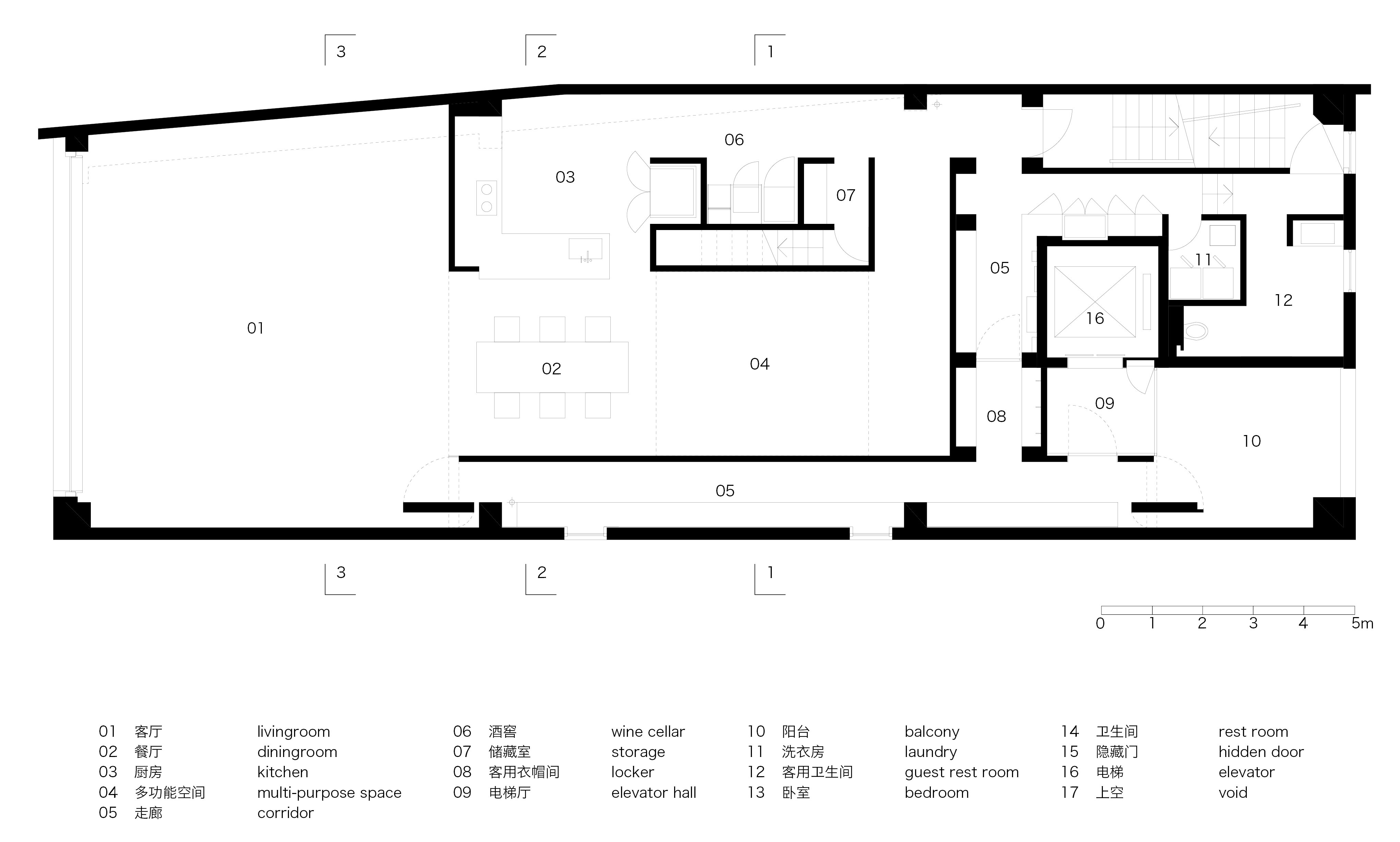





完整项目信息
项目名称:临时栖息地
项目类型:室内设计
项目地点:上海市
建成状态:建成
设计时间:2017年
建设时间:2022年
建筑面积:300平方米
设计单位:优意建筑设计(上海)有限公司
设计单位联系:UNITARCHITECT@126.com
主创建筑师:王云峰
设计团队完整名单:陈涵、耿雯轶、颜小剑
业主:私人业主
摄影师:是然建筑摄影 / schranimage
版权声明:本文由优意建筑设计(上海)有限公司授权发布。欢迎转发,禁止以有方编辑版本转载。
投稿邮箱:media@archiposition.com
上一篇:有方讲座91场(上)|熊星:务实的奇思妙想
下一篇:无锡国际会议中心 / Henning Larsen+联创设计